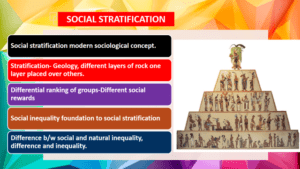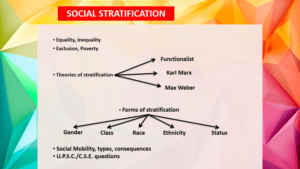INTRODUCTION
- Social stratification is the unequal distribution of resources and opportunities among individuals and groups in a society.
- It affects all members of the society, with some resenting their lower status and others resisting change to the existing system.

- Social structures are not fixed and can change through the actions of their members, particularly through political processes.
- In India, for example, scholars have observed how the electoral process has influenced the reconfiguration and reinforcement of caste identities.
- Additionally, individuals within a society may perceive their position and function within social structures in varying ways.
FUNCTIONAL APPROACH
- The leading proponents of this perspective include Emile Durkheim, A.R. Radcliffe Brown, and Talcott Parsons.
- They view social structures as separate from individual actors and argue that these structures differ across societies, accounting for both similarities and differences between them.

- According to their perspective, individual behavior in social life should be understood in relation to these structures. They stress the importance of closely examining social facts and understanding the patterns of interaction that maintain them. They perceive society as having a normative order that assigns obligations and responsibilities, discourages deviant behavior, and promotes shared values.
All societies need individuals who can be assigned and motivated to perform particular tasks. Each social position comes with specific responsibilities and obligations, and individuals are allocated roles based on their qualifications and capabilities. People are motivated on two levels:
1) The need to fill certain positions;
2) The need to perform the duties attached to certain positions.
This applies to all systems, whether they are relatively stable or somewhat adaptable. It is an ongoing process that occurs in both competitive and non-competitive systems. The nature of the system may influence the level of motivation.
KINGSLEY DAVIS AND WILBERT E. MOORE’S THESIS
The functional theory of social stratification, developed by Kingsley Davis and Wilbert E. Moore, emphasizes-
i) Inevitability of social stratification.
ii) Need for differential intent and ability for different functions.
iii) Differential evaluation of different social positions and duties.
iv) Reward on the basis of differential value attached with different functions.
v) Values and rewards constituting the social differential and stratification.
Therefore, social stratification is a result of the necessity for varying roles and responsibilities, which carry differing levels of power and prestige. The differentiation of roles and responsibilities is essential for the continued existence of human society. Consequently, stratification becomes an unavoidable aspect of social life.
CRITICISM
- Melvin M. Tumin contended that it is not possible to objectively measure the functional significance of any position in society. According to Tumin, the belief “that engineers in a factory are more crucial to its functioning than unskilled workers implies a judgment about the indispensability of the unskilled workers”.
- In essence, Tumin argues that in any production line, every position is interdependent and therefore holds functional importance.
- Additionally, Tumin suggests that a rigid system of stratification may hinder the discovery and utilization of new talent, particularly in the realms of training and education. He asserts that access to training and education may be determined by wealth, thus denying many individuals the opportunity to attain positions that require such qualifications. Based on these ideas, Tumin argued that stratification is detrimental to society.
- Ralf Dahrendorf believes that the regulation of social behavior through positive and negative consequences leads to a hierarchical distribution of status. Compliance is incentivized, while non-conformity is punished.
- Therefore, stratification is inherent in essential aspects of all human societies. The authority framework of a society upholds its system of norms and consequences.
- According to Dahrendorf, the functional theory of stratification does not consider the critical issue of a society’s historical context and its observed existence.
Task question – Explain the fundamental principles of Davis’ structural-functional theory of social stratification. To what extent is it applicable in comprehending contemporary Indian society?
Answer writing pattern–
Introduction:
Davis-Moore theory of social stratification explanation:
Application to Indian context with examples:
Criticism:
Conclusion:



